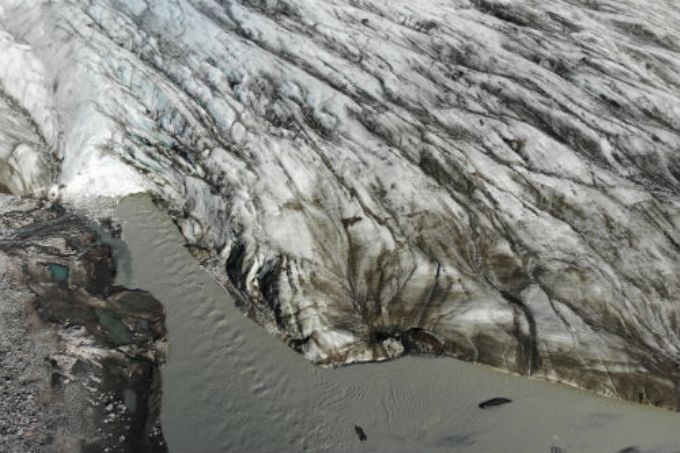Aug 16 2019
Ice sheets which presently cover about 10% of the Earth’s land surface, were believed to be frozen wastelands, barren with no life, and with suppressed chemical weathering 20 years ago—unrelated parts of the carbon cycle.
 Leverett Glacier—SW Greenland Ice Sheet—vast volumes of meltwater and associated carbon and nutrient are exported from ice sheets every year during melt. (Image credit: Dr Stefan Hofer)
Leverett Glacier—SW Greenland Ice Sheet—vast volumes of meltwater and associated carbon and nutrient are exported from ice sheets every year during melt. (Image credit: Dr Stefan Hofer)
Now, a world-leading international team, led by Professor Jemma Wadham from the University of Bristol’ School of Geographical Sciences and Cabot Institute for the Environment, have collated together strong evidence published over the last two decades to show that ice sheets cannot be seen as frozen and passive parts of Earth’s carbon cycle.
Their findings have been published recently in the journal Nature Communications.
A unique set of conditions present beneath ice sheets make them important reactors in the Earth’s carbon cycle.
Jemma Wadham, Professor, School of Geographical Sciences and Cabot Institute for the Environment, University of Bristol
Wadham continued, “Here, grinding of rock by moving ice is high, liquid water is abundant and microbes thrive in melt zones despite inhospitable conditions—the ice sheets erode their bedrock, cold-adapted microbes process the ground rock and boost nutrient release and glacial meltwaters export this nutrient to the oceans, also stimulating the upwelling of further nutrient from depth at glacier marine margins.”
She added, “All this nutrient supports fisheries and stimulates drawdown of carbon dioxide (CO2) from the atmosphere.”
Co-author Professor Rob Spencer from Florida State University added, “Ice sheets are also very effective at storing vast amounts of carbon as they grow over marine sediments, soils and vegetation.
“The Antarctic Ice Sheet alone potentially stores up to 20,000 billion tonnes of organic carbon—ten times more than that estimated for Northern Hemisphere permafrost.
“Some of this carbon is released in meltwaters and fuels marine food webs. The carbon that is left behind in deep parts of ice sheets is converted to methane gas by microbial and/or geothermal activity, which has the potential to be stored as solid methane hydrate under low temperatures and high-pressure conditions.
“We have no idea how stable potential methane hydrate will be in a warming climate if ice sheets thin. There is evidence from past phases of ice sheet wastage in Europe that sub-ice sheet methane hydrate has existed and can be released rapidly if ice thins.”
The research also goes back in time to the last transition from glacial (cold) to interglacial (warm) conditions of the present day, examining ocean cores around Antarctica for signs which might connect ice sheet nutrient (iron) export via Antarctic icebergs to the shifting productivity of the Southern Ocean—a vital global sink for carbon.
Co-author, Dr Jon Hawkings from Florida State University/GFZ-Potsdam, said, “One important way that the Southern Ocean takes carbon out of the atmosphere is by growth of phytoplankton in its surface waters.
“However, these tiny ocean dwelling plants are limited by availability of iron. We have long thought that atmospheric dust was important as a supplier of iron to these waters, but we now know that icebergs host iron-rich sediments which also fertilise the ocean waters as the bergs melt.”
What you see in ocean cores from the sub-Antarctic is that as the climate warmed at the end of the last glacial period, iceberg sediment (and therefore, iron) supply to the sub-Antarctic Southern Ocean falls, as does marine productivity while CO2 rises. While there are many possible causes for the CO2 rise, the data tantalizingly suggests that falling iron supply to the Southern Ocean via icebergs could have been a contributing factor.
Karen Kohfeld, Professor, Palaeo-Oceanographer and Study Co-Author, Simon Fraser University
This study is important as it collates together the work of hundreds of researchers from around the world published over 30 years to prove, via a landmark paper, that ice sheets can no longer be ignored in models of the carbon cycle and under circumstances of climate change.
Ice sheets are highly sensitive parts of our planet—we change temperatures in the air and ocean waters around them and thinning and retreat are inevitable. The evidence we present here suggests that ice sheets may have important feedbacks to the carbon cycle which require further study as the uncertainty is still huge.
Jemma Wadham, Professor, School of Geographical Sciences and Cabot Institute for the Environment, University of Bristol
She continued, “Gaining access to some of the most inaccessible and challenging parts of ice sheet beds, for example via deep drilling, alongside building numerical models which can represent biogeochemical processes in ice sheets will be key to future progress in this field.”
This study is a joint venture between the University of Bristol (UK), University of Leeds (UK), Florida State University and University of California, Riverside (USA), German Research Centre for Geosciences at Potsdam (GFZ) and Geomar, Kiel (Germany), Memorial University, and Simon Fraser University (Canada).